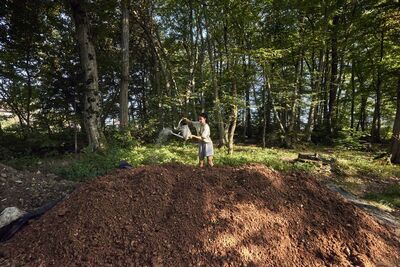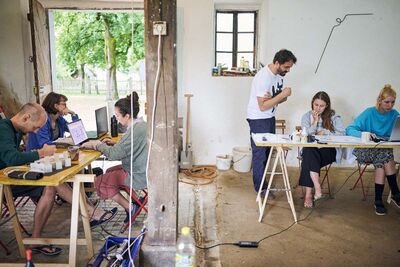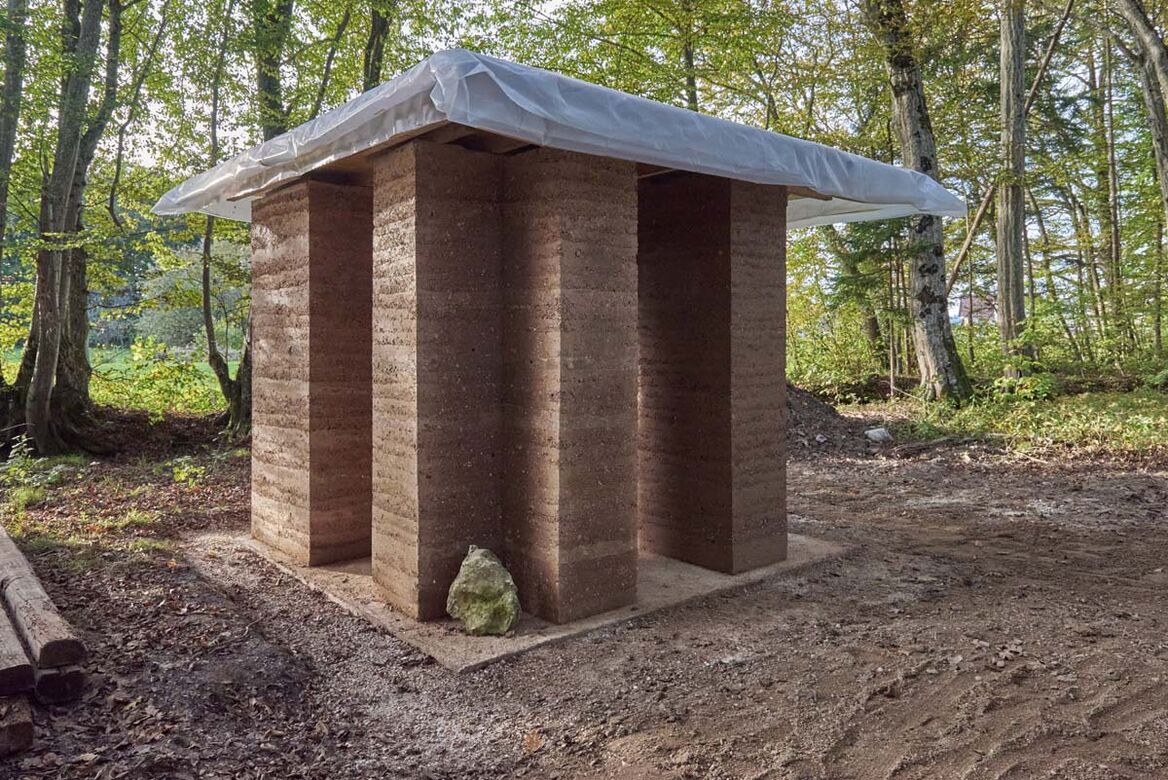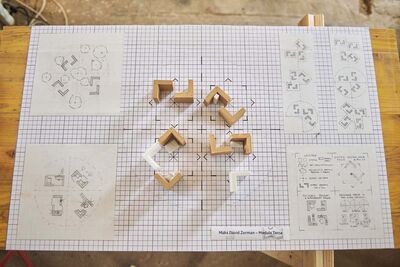Stampflehm als Baustoff?
Lehm ist einer der nachhaltigsten Baustoffe überhaupt. Das größte Hindernis für eine breitere Verwendung dieses Materials in Europa sind die Baukosten aufgrund der hohen Arbeitskosten. Ein slowenisches Team rund um die Gründer Matevž Granda und Nina Granda hat sich auf die Suche nach einer Möglichkeit gemacht, den Bauprozess zu rationalisieren und so die Bauzeit zu verkürzen. Wie das geht, erklären sie auf Englisch im Gespräch mit UmweltDialog.
24.01.2024
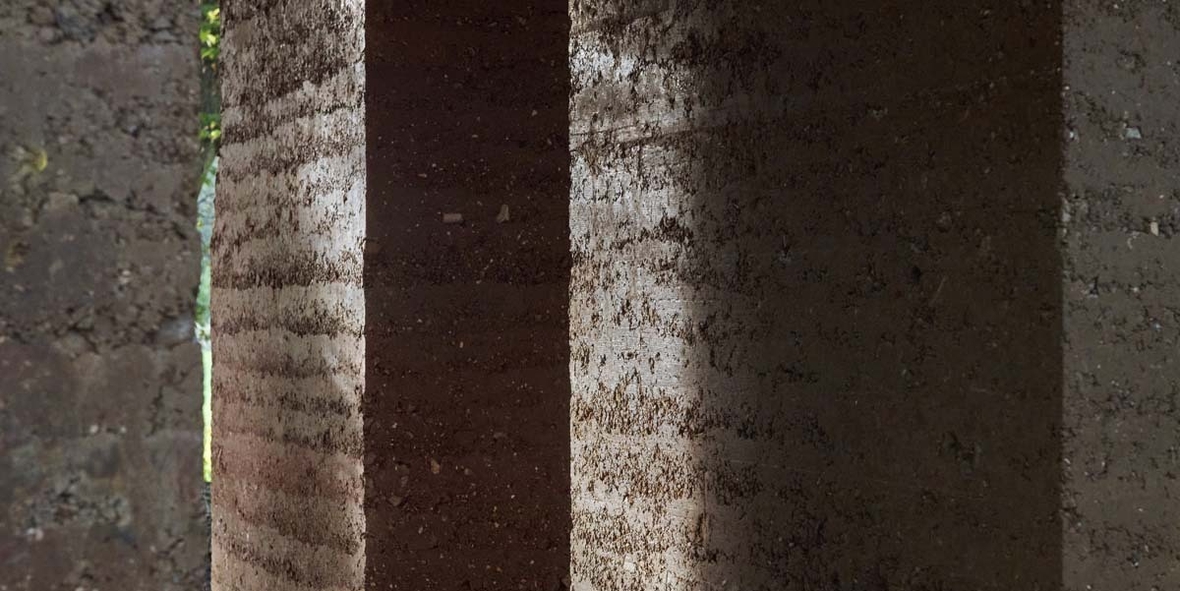
UmweltDialog: What is the project about?
Matevž Granda: Our goal with the project is to address the urgent issue of unsustainable construction materials that contribute to climate change and lead to environmental degradation. We are doing this by developing a modular system for building with rammed earth. Our mission is to make all the parts of the process of building with rammed earth simpler and more cost-effective, which would encourage wide adoption of this sustainable material.
What is rammed earth?
Nina Granda: Earth is one of the most ancient, archaic builing materials – it has been used for millenia in traditional buildings all over the world, and more than a third of world's population currently lives in buildings mede from earth. And no wonder why: earth is readily availible almost evrywhere, is simple to maintain and can be used in a variety of construction methods. It can be mixed with straw, applied to a wooden frame, shaped into bricks, rammed into formwork etc.
The method of building we are most interested in is rammed earth construction, which is the most prevalent contemporaty method for building load-bearing walls with earth. A carefully prepared mixture of loam and sand with a bit of water is laid in sturdy formwork and rammed using manual or pneumatic tools. The process results in a 5-8 cm thick layer of compacted earth. This procedure is repeated until the wall is built. Afterwards, the formwork is removed, and the wall is left to dry for a few weeks. The finished wall features a very beautiful texture and helps with improving living conditions in inside spaces: it regulates humidity in air.
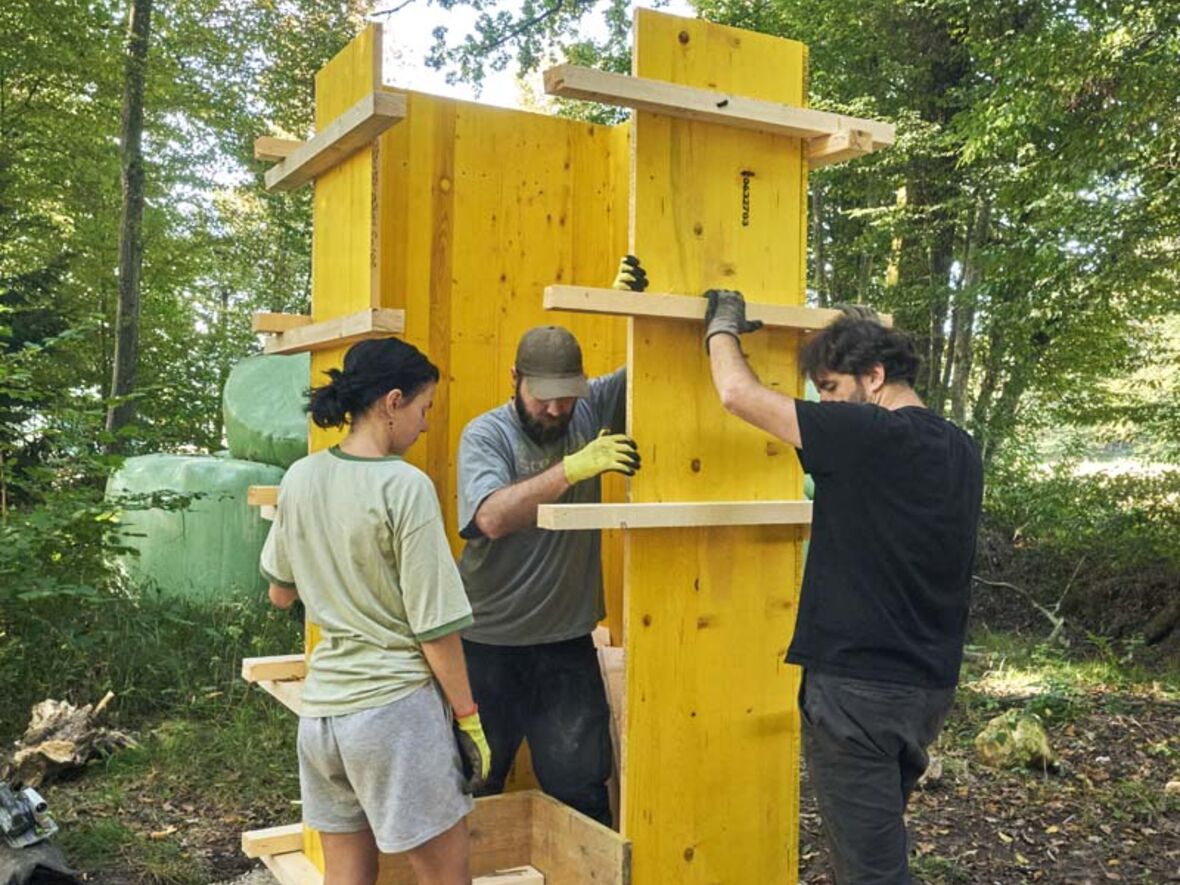
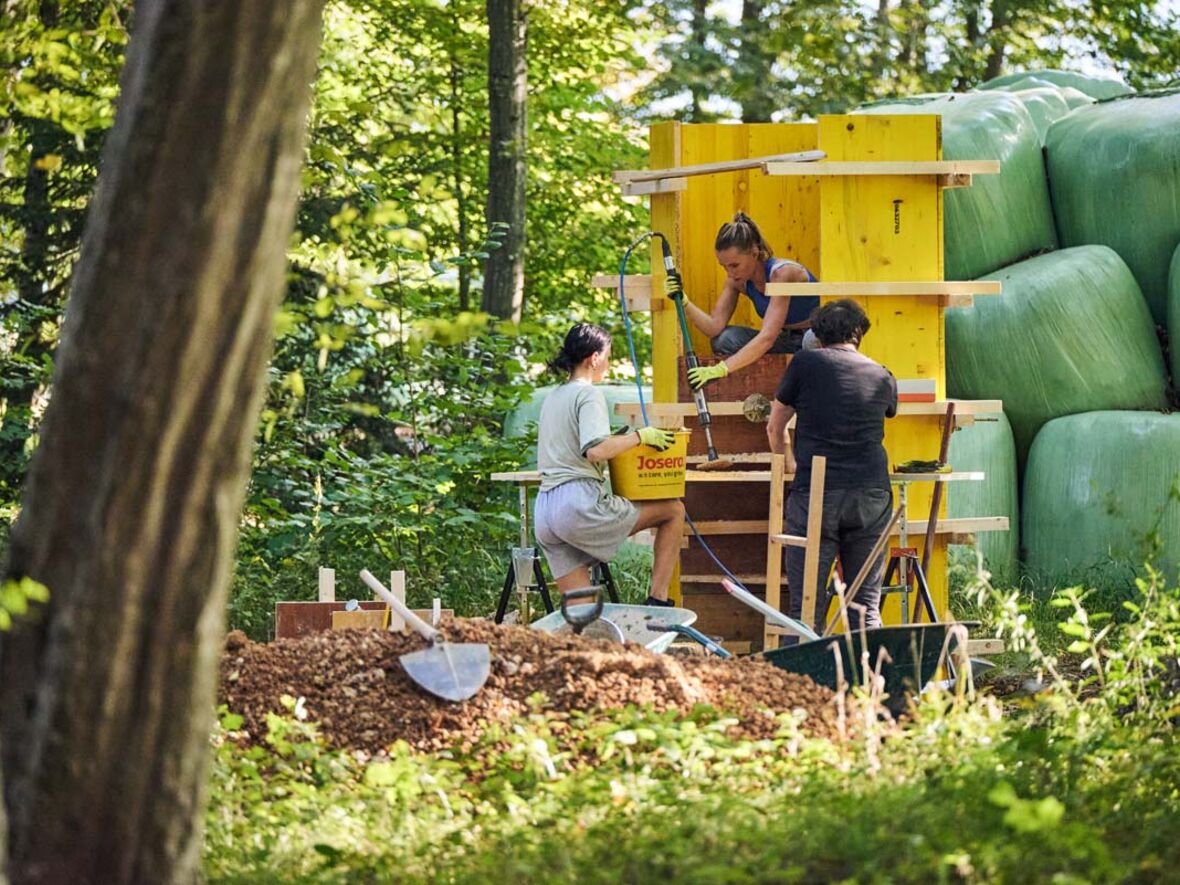
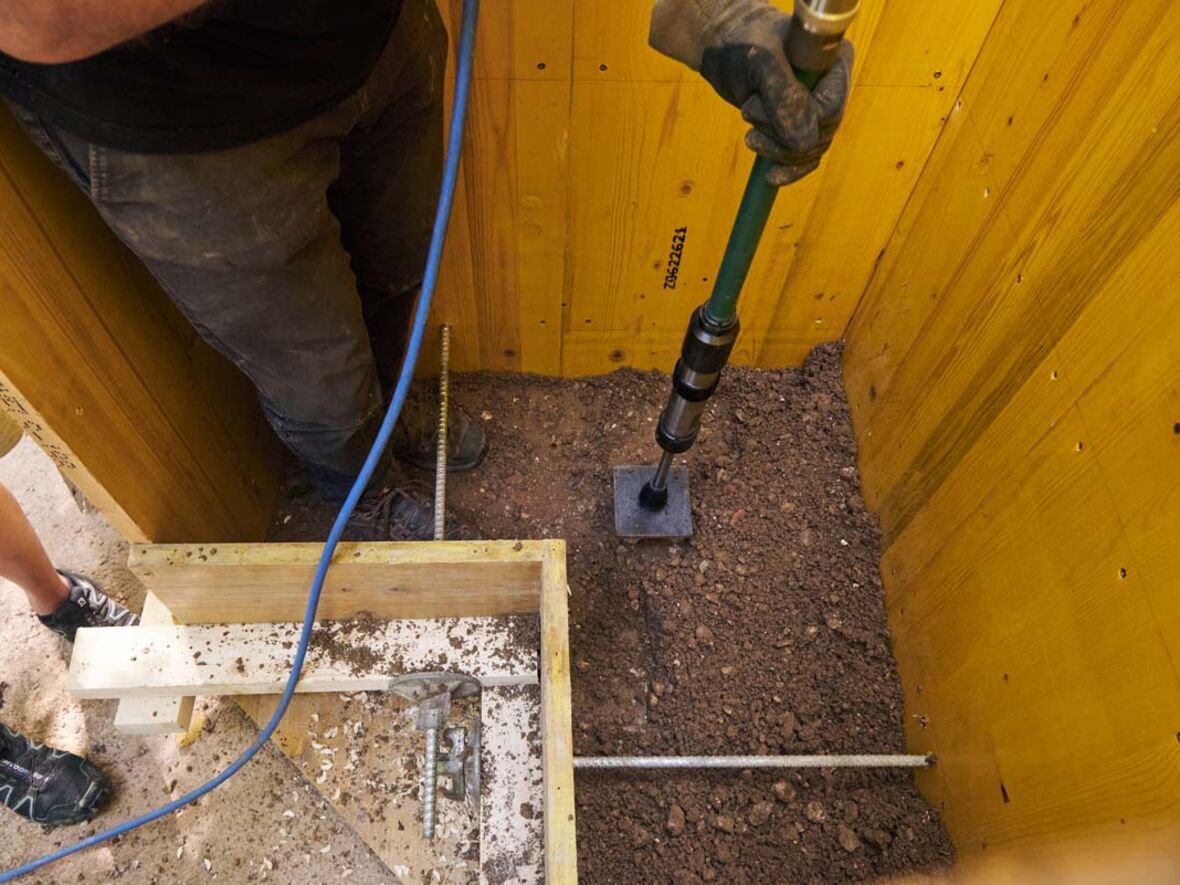
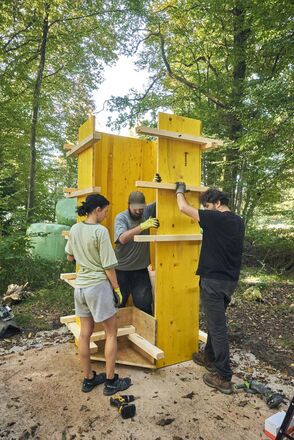
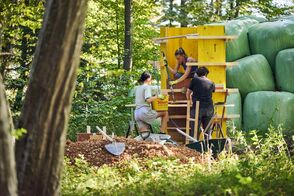
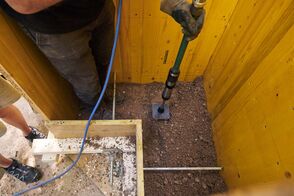
How is it extracted or produced?
Matevž Granda: Appropriate material for rammed earth structures can be in most cases found either on the building site itself or very close to it. Even though we say we are building with earth, we don’t use topsoil with a lot of organic particles, but lower layers: loam, clay and sand. For example: when excavating foundations for the building, the organic layer of earth is removed and set aside. Then, the hole is dug to the required depth. Excavated material is usually partly loam and gravel (depends on the location), which often needs some more gravel or some more clay for optimal mixture.
This is part of the attraction of building with earth: you can’t get more locally sourced material than this.
What makes rammed earth sustainable?
Nina Granda: Let's compare rammed earth with reinforced concrete, one of the most popular conventional building materials. Production of cement alone significantly contributes to climate change: with more than four billion tonnes of cement produced each year, it accounts for around eight percent of global CO2 emissions. Cement manufacture uses a lot of resources, and concrete buildings require additional energy to be demolished, with resulting material having limited use. The production of rebar also uses a lot of energy and resources which again contribute to CO2 emissions. Taking all this into consideration, it becomes clear that if we want to reduce the energy use and CO2 emissions around the world, one of the obvious opportunities is significant reduction in the use of concrete in favor of other, more sustainable materials. And there is barely any material more sustainable than earth.
Earth is availible locally almost anywhere. If not on the building site itself, then in close proximity. This option to source material locally means that the amount of energy needed for transport is very low. Earth also doesn't need a complicated processing before being used. It is also unique among building materials when it comes to the end of building's life: earth can be reused again and again (provided no chemical binders are used). When it comes the time to deposit material for good, it poses no threat for the environment. All this means that carbon footprint of earthen structures is among the lowest of building materials.
What problem can construction with rammed earth solve?
Matevž Granda: We are witnessing a renewal of interest in earthen construction in Europe. Construction engineers, architects and enthusiasts across the continent are experimenting with this material and developing new technologies. Despite various efforts in popularizing earth as a building material, its adoption among investors, builders and decision-makers in Europe is slow. There are different obstacles in the way of wider use of earthen constructions, such as issues with legislature, standardisation and concerns about earthquake resistance. But the problem we are trying to solve is the high cost of construction. In Europe, rammed earth stuctures are approximately 30 percent more expensive compared to conventional building methods. The main reason for this higher cost is the amount of manual labor: more man-hours are needed for rammed earth structures. This is not an issue in parts of the world where a whole community can gather and voluntarily help with building, but in Europe, this drives up the cost.
How did the idea originate, and where did the inspiration come from?
Nina Granda: Our primary activity is publishing the Outsider magazine, which is a Slovenian-language magazine and web portal, covering architecture, sustainable design and culture. Martin Rauch, one of the pioneers of contemporary earth construction, was featured in the first issue of the magazine, and we have been covering the topic of earthen architecture ever since. His work inspired us to promote sustainable building practices. Since 2015, we have organized numerous events, exhibitions, round tables and architecture competitions centered around the topic of sustainable building. In 2021 for example, we have organized an international design competition for rammed earth house, for which we had an amazing response: we received 469 entries from all over the world.
After several years of organizing these kinds of events, we felt the need to start with exploration of material ourselves. Last year we have built, with a lot of trial and error, our first rammed earth pavilion at Center for building with earth – our research lab on a farm in rural south-east Slovenia. But the immediate inspiration which led to this project has been our interview with Martin Rauch early this year, when we discussed challenges facing rammed earth construction. From then on, we started thinking about methods we could use to make this building method more affordable. We are very thankful for the opportunity to develop our solution through CIRCE programme: besides funding, CIRCE supported us with mentoring and enabled us to connect with others who are developing exciting new projects.
How does the idea improve or solve the problem?
Matevž Granda: Our solution involves several different modules, which can be combined with each other in a variety of ways, according to the needs of the project at hand. The largest module is a corner section of a wall, 2,4 meters high, with walls extending up to 2 meters in each side. The smallest module, on the other hand, is a straight bench, up to 2 meters in length. Modularity helps with eliminating a lot of unknowns from the process, from planning stage to construction.
Designing new buildings is simpler and faster with elements that have set dimensions and known technical properties. On the building site, use of modules means we can have a set of formwork which is custom made for a specific module. Each of these sets of formwork can be moved by two workers, and is designed to be easy to assemble and put apart. The same set of formwork can be used again and again. By timing and calculating the time and resources it takes to build each module, we can accurately predict the building time, resources needed and cost of the build. All these measures combined enable us to reduce the projected cost of rammed earth structures.
But relying only on technical solutions is not enough. Builder’s skills also play an important factor. When we were developing our system, we had built several large corner modules, to test different formwork sets and building methods. With each module, our workflow became faster and we became more confident. There are a lot of situations where you need to develop a feeling for what is right: when is earthen mixture moist enough? How much ramming is enough and when it’s too much? For these reasons, skilled workers will always be an important part of an efficient process of building.
What challenges does the project face?
Nina Granda: Broadly speaking, there are issues that apply to earthen construction in general. Legislature in this area is different in each country, but in Slovenia, earth as a building material doesn’t yet have a clearly defined standards and conditions for its use.
While we have come a long way in optimizing formwork for our modules, we still see a lot of opportunities for improvement. There are areas of increased pressures and wear-and-tear which become apparent only after repeated use. We are looking out for these and planning future modifications.
Rammed earth walls are vulnerable to moisture (such as rain). While there are methods by which we can protect the walls against rain damage and erosion (plastering the wall, large overhanging roof, protection from ground water …), we are looking into traditional techniques of building with earth, which rely on natural binders to increase the durability of material without compromising its sustainability. In Istria for example, they mixed ox blood with loam to build water tight cisterns for rainwater collection, some of which are still in use.
How far along is the project? What needs to be done for it to become "mass-market ready"?
Matevž Granda: Our long-term goal is to develop the system to the degree that it can be used in residential buildings. But even now, the system is ready for being used for building smaller structures, such as pavilions, market stands, bus stops and a variety of urban furniture.
Thank you for the interview!
Kernteam des Projekts: Matevž Granda, Nina Granda, Patrik Benedičič
Über CIRCE
Das Projekt ist Teil des Netzwerkes des Creative Impact Research Centre Europe (CIRCE). Dieser aus Mitteln der Beauftragten der Bundesregierung für Kultur und Medien geförderte, internationale Think Tank entwickelte im letzten Jahr ein Maßnahmenprogramm, dass Akteur:innen der Kultur- und Kreativwirtschaft passgenau in ihrer Innovationskraft stärkt. Innerhalb kürzester Zeit sind so 58 Projekte entstanden, die den brennenden Themen unserer Zeit begegnen. Sie widmen sich dabei den verschiedensten Themenbereichen, sei es Nachhaltigkeit, Vielfalt, Technologie, Bildung, Teilhabe sowie gesellschaftliches Miteinander und transformatives staatliches Handeln.

